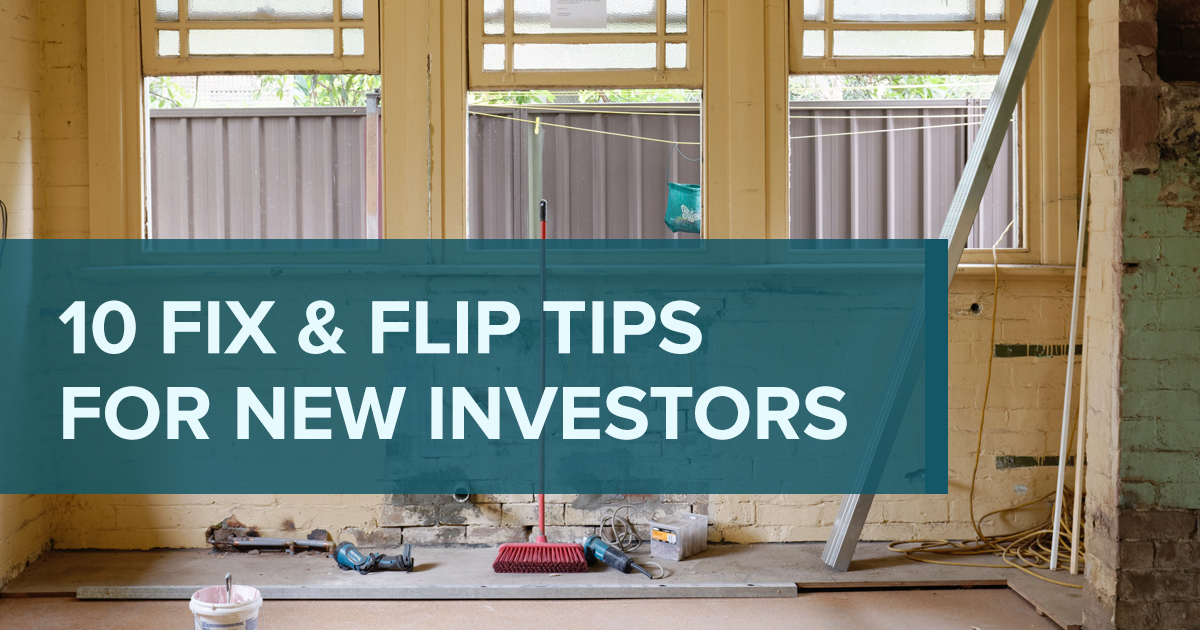No matter the economy — and probably in no small part due to the popularity of HGTV — the fix and flip is always one of the most popular options in real estate. Investors and would-be investors get excited by the potential for low purchase prices during down times, and by high resale during good times.
But flips are not nearly as easy as they appear, though they can be a great money-maker if done right. They demand a tremendous amount of attention to detail, self-control, and just the right amount of flexibility for the inevitable twists and turns of every project.
Interested in taking a rundown house and turning it into a beautiful home? Keep reading to get some real estate investment advice for beginners.
Here are 10 tips for a successful fix and flip from the people who have seen thousands of them:
1. Know your numbers (ARV and the 65%-70% “rule”)
It’s often said that money is made on the purchase, not the sale. And while that might be a bit of an overstatement, it’s certainly true that your numbers make or break the project.
When analyzing a fix-and-flip, you need to have total confidence in the people who help determine your property’s resale value and the estimated rehab costs. Don’t fall prey to the Realtor who paints an overly optimistic picture of the property’s resale or the contractor who lowballs repairs. Educate yourself on all of it, from understanding comparables to knowing how to walk through a property and accurately calculate repairs.
A quick rule of thumb for determining purchase price is to take 65 percent of the After-Repair Value (ARV) and subtracting rehab costs. So if you anticipate selling the property for $200,000 once it’s fixed up and you estimate your repairs at $30,000, your maximum purchase price should be $100,000: ($200,000 x .65) – 30k = $100,000
Remember that this is just a guideline, however. Seasoned investors take a variety of factors into consideration and don’t just rely on a quick-and-dirty calculation. But when first scanning properties online or during a first walk-through, the 65 percent rule can be a handy way to quickly weed out properties that definitely won’t work.
2. Research your contractor
What do you know about this contractor who you’re entrusting your project, your money, and your reputation to? Take the time to research contractors, making sure they’re properly licensed and insured. Check backgrounds and criminal records, and check court records for lawsuits or small claims.
All of this is public information and readily available, typically online. You can Google “license lookup” in your state and court records as well. Also ask your contractor for references for similar projects he’s completed, and go visit a current work site. Any reputable contractor will be happy to have you visit a work site and will gladly provide references. If not, move on.
Any work you do up-front can save you time, money, and loads of frustration later. A good contractor is a joy and helps make rehabbing fun and profitable, while a mediocre or bad one not only makes the rehab painful to deal with, but will likely cost you thousands between delays and poor work.
3. Have a detailed Scope of Work, with milestones
Now that you’ve found a good reputable contractor, don’t think you can skip over formalizing details. You need a contract and a detailed Scope of Work.
This isn’t a trust issue. You want to make sure you and your contractor completely understand each other and the work that’s expected. When you said you wanted the living room painted, how many coats do you want? What color, what sheen, what brand? What do you expect of the prep work? What do you expect for clean-up?
New investors are often surprised at how often a “simple” project or task is misinterpreted (to put it kindly). Again, the time spent up front on this detail will save you time and money on the back end.
Make sure you assign milestones along the way, NOT just one deadline to be finished with the entire project. Attach payments to the milestones that you and your contractor each agree to. You want to be fair to the contractor and understand that he has to purchase materials up front and pay his subcontractors, but you also want to be sure you don’t get so far ahead in payment that the contractor is not motivated to keep things moving. This is why most lenders disburse renovation funds in arrears according to a draw schedule.
4. Include contingency
So you think this project needs $20,000 in work? Budget for $23,000.
You may find that you don’t need to be quite so conservative, but especially in the beginning, expect the unexpected. You’ll tweak this as you gain experience, but it’s often a good idea to add about a 10 percent contingency into your rehab estimate.
You’ll find this is an area of hot debate among rehabbers (then again, most everything is an area of hot debate)! Many use a lower figure and some use a higher one.
The most important thing is to recognize that your $20,000 quote is quite likely to wind up higher by the time you’re done. Things happen: you find surprises in the walls when you take down sheetrock, the house needs a bit more work than it first appeared, or your inspection doesn’t go as planned and you need to fix something you hadn’t expected to.
5. Overestimate and Underestimate – but not too much
As with the contingency, you want to be conservative on the whole … but not so much that you price yourself out of the bidding. It’s a balance that you get better at with experience.
As a general rule, assume your rehab expenses will cost a bit more than you originally expect, and assume the low end on your resale value.
This approach gives you a buffer to profit, and, as you get better and better, you’ll find yourself coming in at budget and selling for the price you wanted more and more often.
6. Get your feet wet locally
Find projects close to home when you start out rehabbing. Don’t be dazzled by the prospect of those $5,000 houses you can buy out-of-state and quickly flip for big bucks. They’re landmines.
You want to see the property in person, for one thing. But it’s also vital that you learn how to accurately analyze the resale.
You know your local area and how property values not only fluctuate from town to town, but from neighborhood to neighborhood. One or two streets so often makes a huge difference, and only a local knows this.
So stay close to home until you learn the intricacies of the business, including how to find Realtors you can trust.
7. Go the extra mile
If you plan to become a regular, understand that contractors and Realtors will quickly get to know you and your projects. If you make sure you become known for quality and courteousness, you’ll not only get more business and better service out of your service providers, but your properties will sell faster, too.
Word gets out quickly about the flippers who think they can slap paint on the walls and try to pass off a poorly-done rehab. But it also gets out quickly who the rehabbers are who take the time and care to truly fix any issues and ensure a house is safe as well as looks great.
8. Don’t quit your day job
There are good reasons to keep your day job, aside from having a personal safety net. You’ll want a good credit score and a proof of income when you look for lenders. Traditional lenders like banks and credit unions need to see these, and even hard money lenders will use this information as support for their decision-making.
So until you build up a good working relationship with a few lenders and also have enough income to show from your self-employment endeavors, it’s a big help to hang onto your 9-to-5.
9. Staging and professional photos
Do these two things, and your rehabs will jump off the page. Most sellers don’t take the time or the money, nor do their Realtors — all you have to do is scan a handful of listings to get a sense of how mediocre the photos are.
Try to budget for a professional to stage your property after you’re rehabbed it. This doesn’t have to cost a lot, but can more than pay for itself; staged properties sell faster and for more. You can rent furniture, hang inexpensive artwork, and install mini-blinds.
Also be sure to have a cleaning crew in to make the house sparkle. Contractors should leave things broom clean, but that’s different than a truly clean house.
Professional photos, by a photographer who knows how to shoot real estate, will help you get more showings. The more potential buyers you get through the door, the faster you’ll sell.
10. When selling, get deposits
It feels like a long time between the day you first saw the property to the day you get an offer to resell it, and you’re eager to collect your hard-earned money.
Make sure you stay focused down the stretch. Stay firm with potential buyers, taking the same care on this step as you did in researching your property and your contractors. Here, just as then, you want to weed out any problem areas right from the beginning.
This includes requiring a significant downpayment, when possible, and making it somewhat difficult to get extensions. Ask for additional deposit money if the buyer wants to extend the closing date. You want buyers whose finances are in order and who are serious about purchasing your property.
While a decent-sized down payment is no guarantee they won’t back out of a contract, it does help you to make sure you’re negotiating with more serious buyers.
If your buyers are financing with FHA and the like, their deposits will be lower and your process will likely take longer. This is fine, but make sure you understand all the steps involved and stay on top of it, same as everything else you’ve done until now.
Remember, a successful flip involves a lot more preparation and sweat than you see on TV. You do want to move as fast as possible, from the initial bid and purchase through the rehab and sale, but not at the expense of being thorough.
It’s better to lose out on a purchase or to take an extra few days getting the rehab done right, than it is to rush through any of the steps. Soon enough, you’ll find yourself getting faster and better, and your reputation for quality projects will pay big returns.







Looking for a small farm
With buildings on it